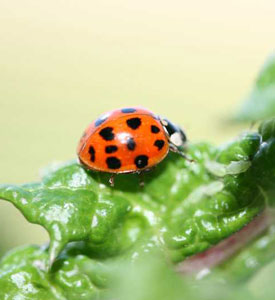
By Linda Wiggen Kraft
If all the creatures that are part of our gardens, there are some that do extra work. Called beneficials, they are the insects, spiders and birds that act as predators or parasites to keep bad insects in check. Some beneficials also help with pollination and decomposing garden matter.
Of the close to one million species of insects worldwide a very small percentage damage plants. Attracting insects and birds in general attracts many more “good” insects for the garden. Some beneficials we are familiar with are ladybugs, praying mantis, parasitic wasps and lacewings. There are many others including parasitic flies, hover flies, assassin bugs, predatory bugs, ground beetles and damsel bugs.
There are six main things to do for beneficials. First, create a thriving ecosystem by planting a wide variety of plants with blossoms from early spring to late fall. Flowering plants with small flowers in clusters like aster, carrots, zizea and dill are favored by beneficials. Native plants evolved with the insects in our region and often offer the most in food and shelter. Provide moisture with a pebble tray filled with water.
Second, get to know and identify garden insects, both “good” and “bad”. Often an insect will do damage to a particular kind of plant. Looking for the insect and what it does helps identify the problem and solution. There are online photos and lists that help with identification. Sometimes the “good” insect resembles the “bad” one, so be careful with identification. Learn what beneficials will be best for particular problems. Praying Mantis is a voracious eater of all insects, good and bad. Ladybugs, or more correctly lady beetles, and their larvae feed on aphids. Parasitic wasps lay their eggs into caterpillars.
Third, bring more beneficials in if needed. Beneficial insects, usually in egg form, can be purchased and added to your garden. Make sure to provide the ideal conditions or they will move on to a more hospitable spot.
Fourth, redefine how a garden should look. Often as we get to know the living creatures of our garden ecosystem, our definition of “good” and “bad” changes. Neat circular cuts in rose and lilac leaves are sometimes found in spring. It is the work of native leafcutter bees, who are very efficient pollinators and should be welcome in any garden. The “damage” done is minimal and only during the time they use the leaves to line nests. Monarch caterpillars are very hungry. They eat leaves of asclepias, milkweed, and other plants. The chewed leaves are exactly what we want to see, indicating more caterpillars and therefore more monarch butterflies.
Fifth, if beneficials aren’t enough to take care of insects and their damage, use pesticides with great caution. Fogging of garden areas, organic or non-organic, kills all insects including beneficials. Keep garden areas clean and remove standing water. Organic pesticides should be applied according to directions. Some need application late in the day when bees and other insects are not feeding on flowers.
Sixth, enjoy the rich diversity of the ecosystem of your garden with all its plants, insects, bird and other life forms. Know that you are helping create a balanced habitat for the web of life.
Linda Wiggen Kraft is a landscape designer who creates holistic and organic gardens. She is also a mandala artist and workshop leader. Visit her blog: CreativityForTheSoul.com/blog or on her website: CreativityForTheSoul.com. You can call Linda at (314) 504-4266.


